In an age marked by ever-evolving cyber threats, safeguarding critical infrastructure and sensitive data has become a paramount concern for the U.S. Department of Defense (DoD). To address these challenges head-on, the DoD has developed a robust cybersecurity initiative known as Highly Adaptive Cybersecurity Services (HACS). This article will provide an in-depth exploration of HACS, its core components, and the pivotal role it plays in fortifying the cyber defenses of one of the world’s most critical governmental bodies with Cloud Computing Technologies GSA Multiple Award Schedule (MAS) 47QTCA23D000J SIN 518210C 54151HACS and 54151S.
Understanding Highly Adaptive Cybersecurity Services
Highly Adaptive Cybersecurity Services (HACS) represents the DoD’s proactive response to the relentless onslaught of cyber threats. It is a comprehensive suite of cybersecurity solutions and services tailored to bolster the security posture of the DoD’s complex digital ecosystem. HACS is designed to provide the agility and adaptability necessary to protect against an ever-expanding array of cyber adversaries, both foreign and domestic.
Unlock the future of intelligent applications with our cutting-edge Generative AI integration services!
The Core Components of HACS
HACS comprises four core components, each dedicated to specific aspects of cybersecurity resilience:
- Protect: The “Protect” component focuses on preventing cyber threats from infiltrating DoD systems. It encompasses services like intrusion detection and prevention systems, firewall management, and secure web gateways. By establishing robust perimeter defenses, the DoD can thwart cyberattacks before they breach critical systems.
- Detect: “Detect” is all about early threat identification. This component utilizes advanced monitoring, analytics, and continuous threat assessment to identify potential intrusions and anomalies. Rapid detection is crucial for minimizing damage and initiating swift incident response.
- Respond: When cyber threats do breach defenses, the “Respond” component kicks into action. It includes incident response planning, cyber forensics, and cyber hunt capabilities. The goal is to mitigate the impact of incidents, minimize downtime, and recover critical systems and data swiftly.
- Recover: The “Recover” component focuses on restoring normal operations after a cyber incident. It encompasses services like backup and recovery, continuity planning, and resilience testing. By prioritizing rapid recovery, the DoD can maintain mission-critical functions even in the face of cyber disruptions.
The Adaptive Nature of HACS
What sets HACS apart is its adaptability. Cyber threats are constantly evolving, and HACS is designed to evolve with them. This adaptability allows the DoD to stay ahead of emerging threats and rapidly adjust its cybersecurity strategies and technologies to meet new challenges. HACS can pivot to address zero-day vulnerabilities, advanced persistent threats (APTs), and other cutting-edge attack vectors. This adaptability ensures that the DoD’s cybersecurity defenses remain highly effective in the face of a dynamic threat landscape.
HACS in Action
To appreciate the real-world impact of HACS, consider a scenario where a sophisticated APT group attempts to infiltrate a critical DoD network. The “Detect” component of HACS identifies unusual network behavior and alerts cybersecurity experts. The “Respond” team immediately initiates an incident response plan, isolating compromised systems and analyzing the breach’s extent. Meanwhile, the “Protect” component continues to fortify perimeter defenses to prevent further intrusions. Finally, the “Recover” team works diligently to restore affected systems, minimizing downtime.
This coordinated and adaptive response demonstrates how HACS can effectively safeguard DoD networks, ensuring operational continuity and data integrity.
-
 GSA SIN 54151HACS Principal Security Architect$153.15 / Per Hour
GSA SIN 54151HACS Principal Security Architect$153.15 / Per Hour -
 GSA SIN 54151S IT Consultant$81.12 / Per Hour
GSA SIN 54151S IT Consultant$81.12 / Per Hour -
 GSA SIN 518210C Cloud Senior Microservices Consultant$129.41 / Per Hour
GSA SIN 518210C Cloud Senior Microservices Consultant$129.41 / Per Hour
Benefits of HACS for the U.S. Department of Defense
HACS offers numerous benefits to the U.S. Department of Defense:
- Enhanced Security Posture: HACS provides a multifaceted approach to cybersecurity, bolstering defenses, and ensuring a strong security posture.
- Rapid Response: The adaptive nature of HACS allows for swift detection and response to cyber threats, minimizing their impact.
- Continuous Monitoring: HACS enables the DoD to maintain 24/7 monitoring of its digital infrastructure, ensuring that no threat goes undetected.
- Adaptability: As threats evolve, HACS can adapt quickly to address new challenges and vulnerabilities.
- Mission Assurance: By protecting critical systems and data, HACS ensures the DoD’s ability to carry out its vital missions without interruption.
Conclusion of Highly Adaptive Cybersecurity Services for DoD
Highly Adaptive Cybersecurity Services (HACS) is the linchpin of the U.S. Department of Defense’s cybersecurity strategy, providing agile, adaptable, and comprehensive protection against the ever-changing landscape of cyber threats. As technology advances and adversaries become more sophisticated, HACS continues to evolve, ensuring that the DoD remains at the forefront of cybersecurity resilience. In an era where cyber threats are constantly evolving, HACS stands as a critical shield defending the integrity, security, and resilience of the DoD’s digital infrastructure.

